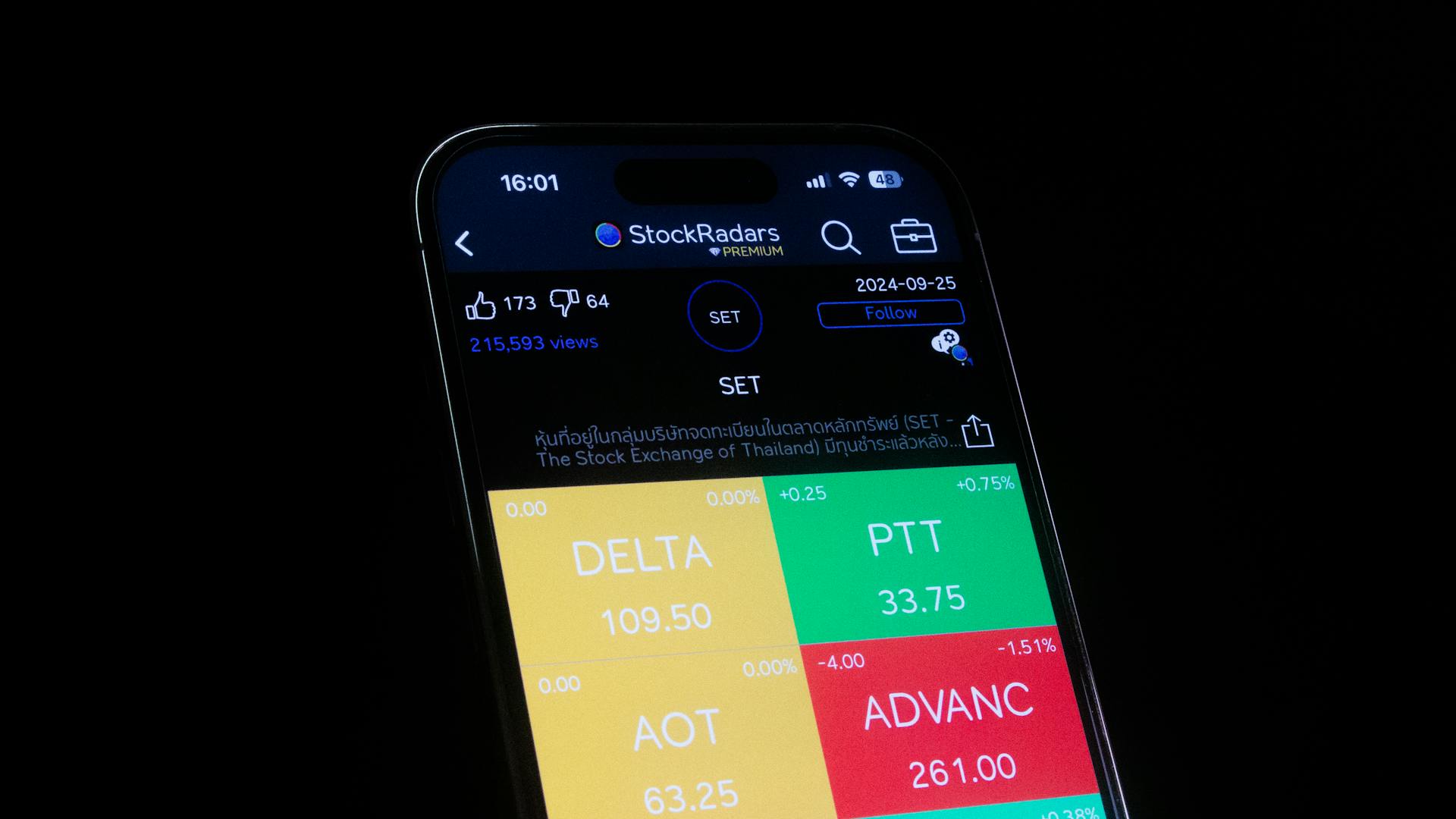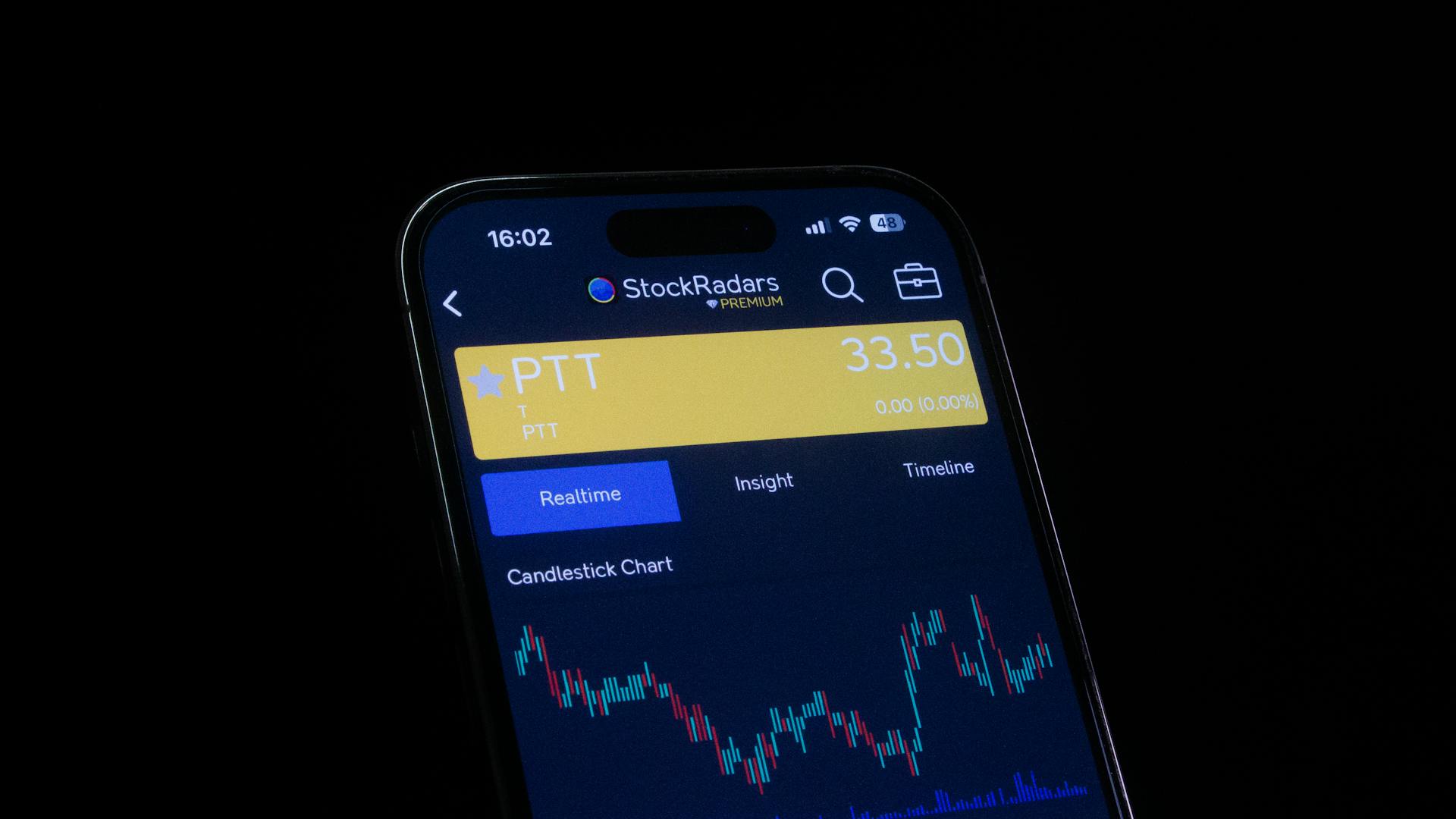
As a day trader, you're no stranger to the thrill of the market, but you may not be as familiar with the tax implications of your trading activities. Day traders can deduct business expenses on their tax returns, which can significantly reduce their taxable income.
You can deduct the cost of equipment, software, and other tools necessary for trading, such as computers, monitors, and trading platforms. This can include the cost of a trading desk or a comfortable workspace.
The IRS also allows day traders to deduct expenses related to travel and education, such as conferences and seminars. These expenses can be deducted as business expenses on your tax return.
By taking advantage of these tax deductions, day traders can save thousands of dollars on their tax bill each year.
Suggestion: Accrued Expenses Tax Deductible
How to Deduct Losses
You can deduct losses from your day trading taxes, but there's a limit to how much you can deduct. You can only deduct a total of $3,000 per year, or $1,500 if you're married and filing separately.

To deduct losses, you'll need to report them on Form 8949 and Schedule D. These forms are used to report both gains and losses.
You can deduct losses on the sale of anything the IRS considers an asset, including stock, land, or works of art.
To keep track of your capital gains and losses, keep an eye out for Form 1099-B or Form 1099-S from your broker, bank, and any other financial firm with which you do business.
The IRS has a rule called the wash sale rule that prohibits you from buying back a security you sold within 30 days if you're trying to realize a loss. This rule is in place to prevent investors from easily realizing losses and then buying back the same security.
If you have losses that exceed $3,000, you can carry them over to the following year and deduct them against other forms of income. This can be a long process, taking up to seven years to deduct all of your losses.
Here's a summary of how to deduct losses:
- Report losses on Form 8949 and Schedule D
- Keep track of your capital gains and losses with Form 1099-B or Form 1099-S
- Be aware of the wash sale rule and its 30-day waiting period
- Carry over excess losses to the following year and deduct them against other income
Understanding Tax Rules
You can reduce your short-term capital losses from your short-term capital gains, but the total deduction is capped at $3,000 per year, unless you're married and filing separately, in which case it's $1,500.
If you have losses that exceed this amount, you can't claim them, but they'll be rolled forward to your taxes as normal losses. However, there are exceptions to this rule if you qualify as marked-to-market or have Trader Tax Status.
Trader Tax Status allows you to deduct interest as an expense, educational expenses, and even take a home office deduction if you work from home. This status also lets you make an election for mark to market, which eliminates the wash sale rule and lets you claim greater losses.
Here's a summary of the key tax rules for day traders:
Remember, tax rules can be complex, so it's essential to keep accurate records and consult with a tax professional if you're unsure about any aspect of your tax obligations.
What Is the Mark-to-Market Rule?
The mark-to-market rule is an exception to short-term capital gains taxes that allows traders to claim more than $3,000 in capital losses on their income tax.
To invoke this rule, traders must make an election to the IRS by April 15th of the previous tax year, and if granted, they can count their gains or losses as business property.
This means they can report more losses as business costs rather than living costs, effectively reducing their tax liability.
The mark-to-market rule is a method of accounting that adjusts the value of an investment to its current market price, which is its fair value at the end of the year.
Taxpayers will need to file a tax return with the Internal Revenue Service for any changes, and this rule is often referred to as mark-to-market accounting.
Related reading: Brokers with No Pattern Day Trader Rule
What Is Status?
Trader tax status is a designation that comes with several benefits for traders. It allows them to deduct interest as an expense, among other things.

If you're a trader who works from home, you can take a home office deduction. This can be a significant advantage, especially if you're using a dedicated space for your trading activities.
Traders with trader tax status can also deduct educational expenses, such as stock trading seminars and educational materials, if they itemize and the expenses exceed 2% of their adjusted gross income.
The mark to market election is a key benefit of trader tax status. It allows traders to claim greater losses, if applicable, and eliminates the application of the wash sale rule.
Take a look at this: How to Become a Day Trader from Home
Wash-Sale Rule Exemption
The wash-sale rule exemption is a valuable exception to the wash-sale rule, which can help you avoid disallowed losses. This exemption is available to traders who use the mark-to-market accounting method.
If you're classified as a trader, you can be exempt from the wash-sale rule. This means you can deduct losses even if you buy the same asset within a short period of time, as long as you're using the mark-to-market accounting method.
Consider reading: What Is the Ny New Rule for Business Taxes

To qualify for this exemption, you must be a trader, not an investor. Traders are subject to different tax rules than investors, and this exemption is one of the benefits of being classified as a trader.
The mark-to-market accounting method allows you to report gains and losses on your investments as they fluctuate in value. This method is only available to traders, and it can help you avoid disallowed losses due to the wash-sale rule.
Here are the key facts about the wash-sale rule exemption:
By understanding the wash-sale rule exemption, you can take advantage of it and avoid disallowed losses.
Capital Gains: Short-term vs. Long-term
As a day trader, it's essential to understand the difference between short-term and long-term capital gains. Short-term capital gains occur when you sell an investment within a year of buying it, and they're taxed as ordinary income, ranging from 10% to 37%.
You can be taxed at higher short-term capital gains tax rates because, as a day trader, you're typically selling assets you've owned for a shorter time.
Explore further: Bill Ackman Short

Short-term capital gains are taxed at ordinary income rates, while long-term capital gains have more favorable tax rates, ranging from 0% to 20%, depending on your household income.
Here's a quick breakdown of the tax rates:
As a day trader, it's unlikely you'll experience long-term capital gains, but it's good to know the difference between the two.
Filing and Payment
You'll need to notify the IRS ahead of time to achieve trader tax status, which involves submitting a tax return from the previous year, Form 4868, and a written declaration of your intention to make a mark to market election under section 475(f) of the Internal Revenue Code.
The IRS will respond in writing with their decision on your mark to market election, and when it's time to file your taxes, you'll use Form 4797 to report your gains and losses.
You'll also need to make estimated tax payments throughout the year to avoid tax penalties when you file your tax return, especially if you're a day trader with no one withholding taxes from your paycheck.
Suggestion: File Business Taxes Online Llc
How to File
Filing for trader tax status is a bit more involved than just filing your taxes. You'll need to notify the IRS ahead of time by making a mark to market selection.
To start, you'll need to provide a tax return from the previous year. This will give the IRS a clear picture of your trading activity. Form 4868, the Application for Automatic Extension of Time To File U.S. Individual Income Tax Return, is also required. This form will need to be submitted along with a written declaration of your intention to make a mark to market election under section 475(f) of the Internal Revenue Code.
The IRS will review your application and respond in writing with their decision. This is an important step, as it ensures that you're following the proper procedures for trader tax status.
Intriguing read: How to Check If the Irs Received My Tax Payment
Don't Forget Payments
As a day trader, you're likely used to making quick decisions and staying on top of your finances. You don't have to worry about taxes being withheld from your paycheck, but the IRS still expects you to pay your fair share.
You'll need to make estimated tax payments throughout the year to avoid tax penalties when you file your tax return. This is especially true if you're making a significant amount of money from day trading.
The IRS considers investments held for less than a year to be short-term capital gains, which can be comparable to income tax. So, it's essential to keep track of your profits and losses to ensure you're paying the right amount of taxes.
If you're a day trader with other income streams, such as consulting, you may need to pay self-employment tax on that income. However, if you qualify for trader tax status, you won't have to pay self-employment tax on your day trading income.
As a day trader, it's crucial to stay organized and keep accurate records of your income and expenses. This will make it easier to calculate your estimated tax payments and avoid any penalties when you file your tax return.
See what others are reading: Do I Need Bank Statements for Taxes
Tax Deductions and Forms

You can deduct up to $3,000 in short-term capital losses from your taxes each year, with some exceptions for married couples filing separately.
To deduct stock losses, you'll need to file two additional tax forms: Form 8949 and Schedule D. These forms are used to report both gains and losses.
As a day trader, you may be able to deduct investment expenses as a trading business expense, which can include things like a home office, internet service, and computer costs.
Tax Deductions
You can deduct losses on the sale of anything the IRS considers an asset, including stock, land, or works of art.
Deducting losses can be a great way to reduce your tax liability, but there are limits. You can only deduct a total of $3,000 per year in short-term capital losses, unless you qualify for Trader Tax Status or are married and filing separately, in which case you can deduct $1,500 each.

If you have losses that exceed $3,000, they will be rolled forward to your taxes as normal losses. But if you qualify as marked-to-market or have Trader Tax Status, you may be able to deduct more.
You can also deduct investment expenses as a trading business expense if you're classified as an active trader. This can include things like a home office, the cost of your internet service and computer, office supplies, and subscriptions to trading services.
Any interest expenses from margin loans can also typically be deducted. This can be a big help in reducing your tax liability.
Use Exempt Accounts
If you can get around the issues, day trading in a tax-exempt account could be a good way to reduce taxes.
You can use an individual retirement account (IRA) to grow your money tax-free and avoid owing capital gains taxes at all.
There are limits on IRA contributions you can make each year, so you may not be able to deposit enough, and your brokerage may stop you from continuing to day trade.

Standard margin accounts aren't available in IRAs, but you can consider looking for a brokerage that offers a "limited margin" account.
These accounts require you to keep a large balance in most cases, and you can't borrow against your stocks to make new investments.
You won't have to wait days for funds to settle before making another trade, but be aware that since day-trading is generally considered a risky strategy, you could be putting your retirement security in jeopardy.
Broaden your view: T Rowe Index Funds
By State
If you're a day trader, it's essential to consider the tax implications of your activities. California, Hawaii, and New Jersey are just a few states that have high capital gains taxes for day traders.
These states are among the top 10 with the highest capital gains taxes. Let's take a closer look at some of the states with the most favorable tax laws for day traders.
Here are the top 10 states with no income tax or capital gains taxes:
If you're considering relocating to a state with more favorable tax laws, these states are definitely worth considering.
Tracking and Utilizing
You should receive a Form 1099-B or Form 1099-S from your broker, bank, and any other financial firm with which you do business, containing the information you need to report on your total gains and losses.
To keep track of your capital gains and losses, keep an eye out for these forms in the mail and also check your online accounts for downloadable versions.
You can report your total gains and losses using the information on these forms, which will help you determine your tax liability.
Form 1099-B and Form 1099-S are essential documents for tracking your capital gains and losses, so make sure to review them carefully.
You can utilize tax-advantaged accounts, such as IRAs, to execute trading strategies and defer capital gains taxes, allowing your money to grow over time.
Excessive trading in a retirement account can undermine your long-term goals, so make sure you have a solid plan that aligns with your overall objectives and risk tolerance.
Take a look at this: Does Uniswap Report to Irs
Some tax-advantaged strategies include buying calls and puts, selling covered calls, and more, which can be done in a tax-advantaged account to minimize tax liability.
You can locate and hold investments that generate certain types of taxable distributions within a tax-advantaged account rather than a taxable account, which can help reduce your tax burden.
Here's a summary of the key tax-advantaged strategies:
- Buy calls and puts in an IRA
- Sell covered calls in an IRA
- Hold investments that generate taxable distributions in a tax-advantaged account
Software and Professionals
As a day trader, you'll want to consider software that can help you stay organized and efficient. Trading platforms like Thinkorswim and TradeStation offer a range of tools and features to help you manage your trades and stay on top of your tax deductions.
Day traders often work with financial professionals, such as accountants and tax advisors, to ensure they're taking advantage of all the tax deductions available to them. These professionals can help you navigate the complex world of tax law and ensure you're in compliance with all relevant regulations.
Software like TurboTax and QuickBooks can also help you keep track of your expenses and income, making it easier to claim deductions on your tax return.
Check this out: 401k Tax Deductions Work
Software for DIY

If you're looking to save some expenses and figure out your day trading taxes yourself, one platform allows you to do everything on your own.
You can use this platform to take control of your day trading taxes, and it's a great option for those who want to save some money on professional fees.
No matter what, it's essential to find a solution that works for you and your budget, and this platform can be a great DIY option for day traders.
For another approach, see: Great Day Traders
Best CPAs
Filing your taxes as a day trader can be a real drag. Not only is it time consuming to track all of your trades for the year, but it is easy to make a miscalculation or error.
There are some excellent CPAs out there that can help you with this process. Trader Tax CPA is one of the more well-known and established online CPAs for day traders in the US.
It's a cloud-based CPA firm that offers services such as tax compliance and preparation, trader consulting, accounting, payroll services, and even IRS representation.
Frequently Asked Questions
What qualifies you as a day trader for taxes?
To qualify as a day trader for tax purposes, you must make at least 720 trades per tax year, with each trade being a buy or sell. Meeting this criterion can help you avoid being classified as a "dealer in securities" and potentially reduce your tax liability.
Sources
- https://www.tradingsim.com/blog/day-trading-taxes-guide-for-beginners
- https://www.investopedia.com/articles/investing/111315/deducting-stock-losses-guide.asp
- https://www.fidelity.com/learning-center/trading-investing/tax-trading-tips
- https://andersonadvisors.com/blog/trader-tax-status/
- https://financebuzz.com/reduce-day-trading-taxes
Featured Images: pexels.com

